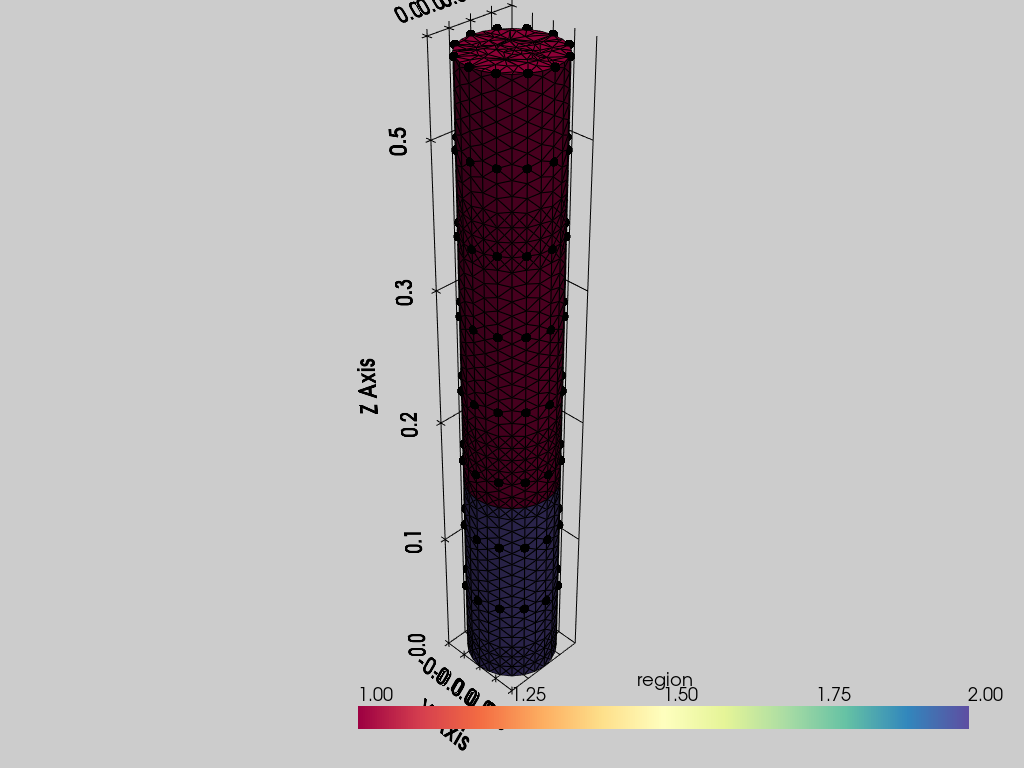Vizualisation of infiltration into a sand column
Water is infiltrated into a sand column and ERT datasets are collected throughout the infiltration. In this example we will invert them with ResIPy using a custom mesh (build withing gmsh UI).
[1]:
import sys
sys.path.append('../src')
from resipy import Project
import numpy as np
import pyvista as pv
testdir = '../src/examples/'
API path = /media/jkl/data/phd/resipy/src/resipy
ResIPy version = 3.4.6
cR2.exe found and up to date.
R3t.exe found and up to date.
cR3t.exe found and up to date.
Let’s import the surveys, electrodes (with correct label <string> <elecNumber>) and vizualise the mesh. The mesh actually has two regions: the top region is the sand where the ERT measurements are done. The bottom region is gravels which are just used for drainage. Note that the last two rings of electrodes which are in the gravels are not actually used in the sequence. However, for correct ERT modelling the entire column needs to be modelled.
[2]:
k = Project(typ='R3t')
k.createTimeLapseSurvey(testdir + 'dc-3d-timelapse-column/data', ftype='ProtocolDC')
k.importElec(testdir + 'dc-3d-timelapse-column/elec.csv')
k.importMesh(testdir + 'dc-3d-timelapse-column/mesh.msh')
k.showMesh()
Working directory is: /media/jkl/data/phd/resipy/src/resipy
clearing dirname
9/9 imported
/media/jkl/data/phd/resipy/pyenv/lib/python3.10/site-packages/pyvista/jupyter/notebook.py:33: UserWarning: Failed to use notebook backend:
No module named 'trame'
Falling back to a static output.
warnings.warn(

Now invert the data. Note that to avoid automatic cropping of the mesh to the region of interest (defined by the maximum extend of the electrodes locations), we need to setup num_xy_poly to 0 and zmin and zmax to \(-\infty\) and \(+\infty\) respectively.
[ ]:
k.param['num_xy_poly'] = 0
k.param['zmin'] = -5
k.param['zmax'] = 1
k.invert(parallel=True)
Writing .in file and protocol.dat... Matching quadrupoles between pairs of (background, surveyX) for difference inversion...done in 0.0136s
done
------------ INVERTING REFERENCE SURVEY ---------------
>> R 3 t E R T M o d e l v 2.31 <<
>> Date: 03-12-2023
>> My beautiful 3D survey
>> I n v e r s e S o l u t i o n S e l e c t e d <<
>> A d v a n c e d M e s h I n p u t <<
>> T e t r a h e d r a l E l e m e n t M e s h <<
>> Reading mesh file
>> Determining storage needed for finite element conductance matrix
>> Generating index array for finite element conductance matrix
>> Reading resistivity model from res0.dat
>> L o g - D a t a I n v e r s i o n <<
>> N o r m a l R e g u l a r i s a t i o n <<
>> Memory estimates:
For 1000 measurements the memory needed is: 0.083 Gb
For 2000 measurements the memory needed is: 0.162 Gb
For 5000 measurements the memory needed is: 0.399 Gb
For 10000 measurements the memory needed is: 0.794 Gb
>> Forming roughness matrix
>> Number of measurements read: 70
>> Total Memory required is: 0.009 Gb
Processing frame 1 - output to file f001.dat
Iteration 1
Initial RMS Misfit: 76.23 Number of data ignored: 0
Alpha: 5.743 RMS Misfit: NaN Roughness: ************
[ ]:
k.showResults(index=0, pvslices=[[0],[0], np.linspace(0.175, 0.455, 6)]) # background model
[ ]:
k.showResults(index=1, attr='difference(percent)', vmin=-50, vmax=0, color_map='Blues_r')
k.showResults(index=2, attr='difference(percent)', vmin=-50, vmax=0, color_map='Blues_r')